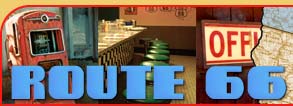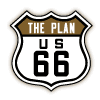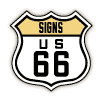|
Today there are three things that Route 66 needs a lot more of to become truly successful in diverting high volume tourist and recreational traffic off the nearby Interstates. Those three things are: signs, signs and MORE SIGNS!
At issue is not that there are no route signs, there ARE signs but it's just that there are not enough signs. In many cases Route 66 is simply not indicated at the intersections or junctions with adjoining highways.
A Route 66 Impact Study was conducted by David Listokin at the Edward J. Bloustein School of Planning of Rutgers University which brought many facets of Route 66 to light. A poll of Route 66 travelers was conducted in which feedback was requested of their Route 66 experiences. According to the study (page 20), "...the respondents noted challenges to travel along the Mother Road, with the number one complaint being 'Finding it' (e.g., 'finding it at all'; 'finding intact sections'; 'finding original route'; 'finding the Route in urban areas-disagreement on multiple routes'; 'finding it in some states'; 'lack of signage'; and lack of consistent signage"). [Emphasis ours].
A few years ago, a president from a Route 66 Association in a western state joked with us that he was "sick and tired of being asked by tourists how to find Route 66 when, in fact, they were already on it!" And all of this in spite of the fact that Route 66 is now a scenic or historic "Byway" in every state except Texas and California. (Calif. was still pending as of this writing).
As the Rutgers poll confirms, the level of signage is worse in some states than in others. According to the Route 66 Chamber of Commerce, Arizona, Missouri and Kansas have the best signage but even in those states, gaps, missing signs and unmarked turns can be found. For the latest rating on U.S. Route 66 marker signs, see state route 66 signage ratings page.
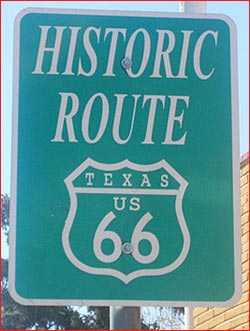 Part of the problem might be that "Byway" and other "Historic" markers are intended to be more commemorative in nature than to be used for actual traffic control guides. Unfortunately, it is just such traffic guides that are needed. A good way to address this situation is to restore or "recommission" the official "66" U.S. Route designation along all portions of Old Route 66 now designated as "Byway" and connect any disjointed segments by co-designating Interstate highways as U.S. 66 when necessary. (See The Plan).
Part of the problem might be that "Byway" and other "Historic" markers are intended to be more commemorative in nature than to be used for actual traffic control guides. Unfortunately, it is just such traffic guides that are needed. A good way to address this situation is to restore or "recommission" the official "66" U.S. Route designation along all portions of Old Route 66 now designated as "Byway" and connect any disjointed segments by co-designating Interstate highways as U.S. 66 when necessary. (See The Plan).
The FHWA's Manuel of Uniform Traffic Control Devices (MUTCD) clearly shows how signs need to be arranged around junctions with other highways. Below are a couple of examples of the kind of guide markers that are needed around junctions with other highways:
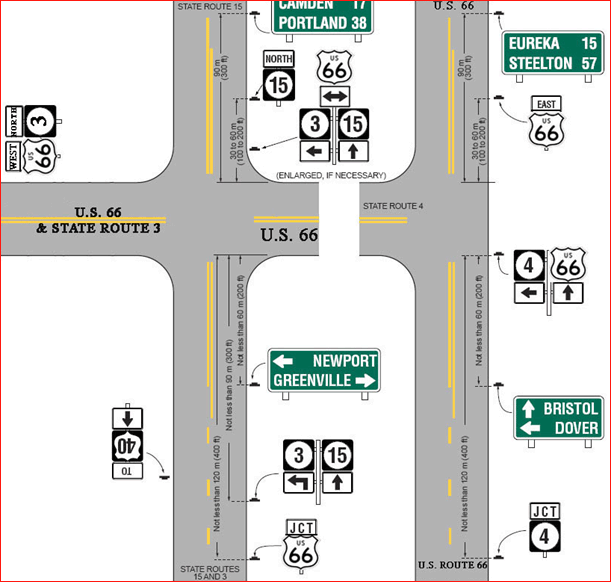
Indicated in the sketches are what's known in some circles as "California" style U.S. Route "cutout" shields which are quite attractive. However, the critical point to grasp here is that it is not so much what style of marker is used as the simple fact that some kind of markers are provided. So called "Historic" markers can also be employed in such a way as to actually function much like U.S. Route markers. Below is a similar set of junctions where "Historic" markers were used in place of conventional U.S. Route markers.
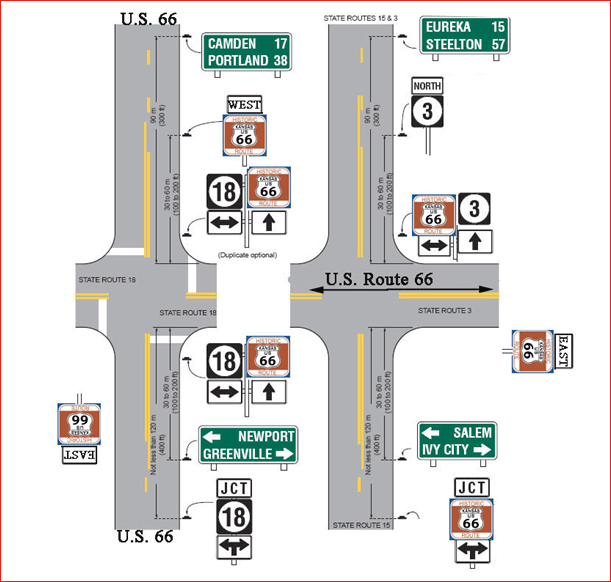
Similarly, "Byway" signs could also be employed as shown in this example:
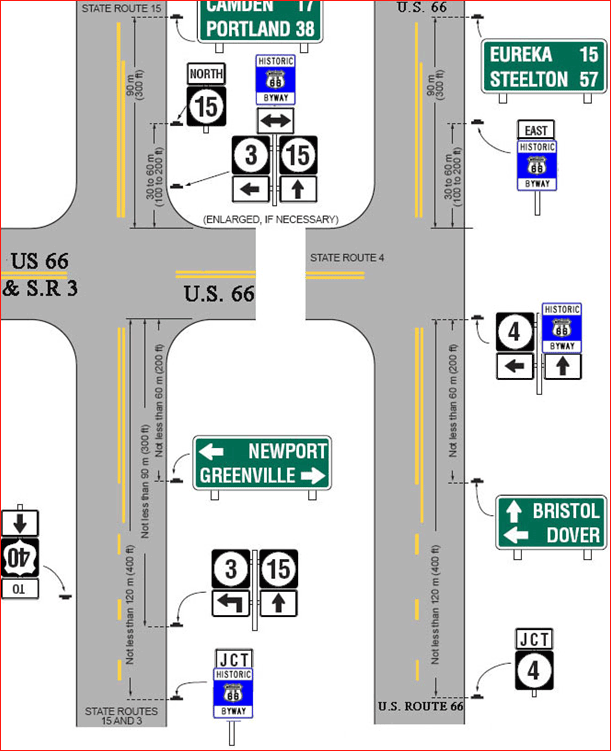
It should be noted that these diagrams are for example only to show how Route 66 junctions need to be signed. The specific locations indicated, however, are entirely fictitious.
Another type of important marker arrangement can be used to clearly show a division of routes where two routes have been coinciding or "sharing pavement" for a certain distance and then part ways as shown in this illustration:
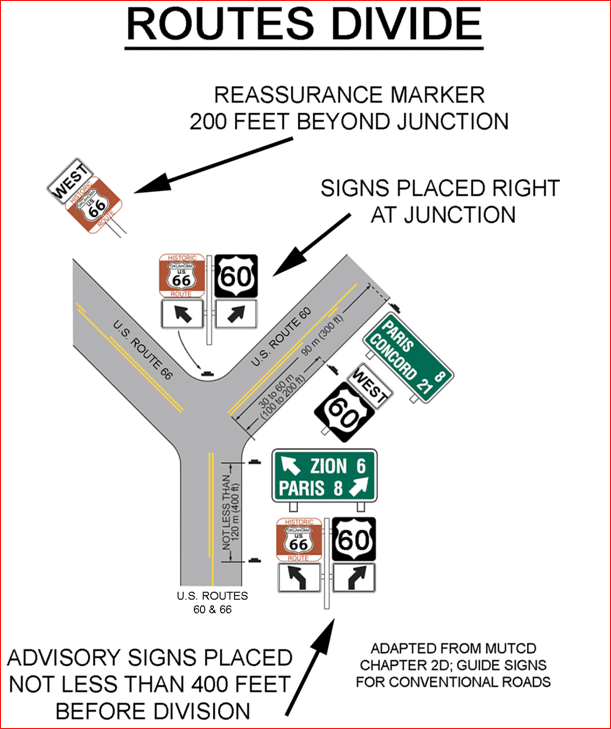
Perhaps most critical of all are signs needed at the junctions of Route 66 and Interstate highways. Today, much of our travel moves on the Interstate and it is largely from the Interstate that tourists, vacationers and recreation-oriented travelers are going to go looking for Route 66. Therefore, it is absolutely imperative that the exits are well signed. The following sketch illustrates an example of ideal signage that should be found along an Interstate highway. Once again the specific details of the location are partly fictitious.
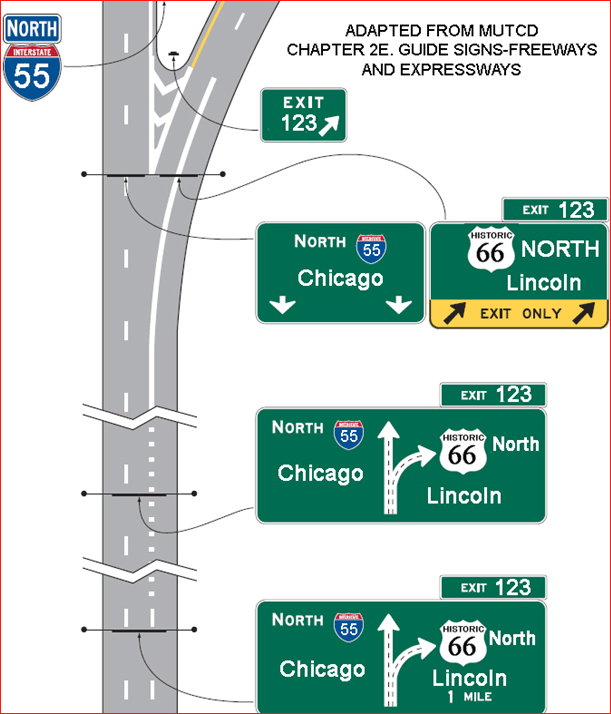
After a traveler leaves the expressway as shown in the above example, he or she would then drive down the exit ramp which in turn invariably comes to an end at a stop sign (or traffic light) as shown in the following example:
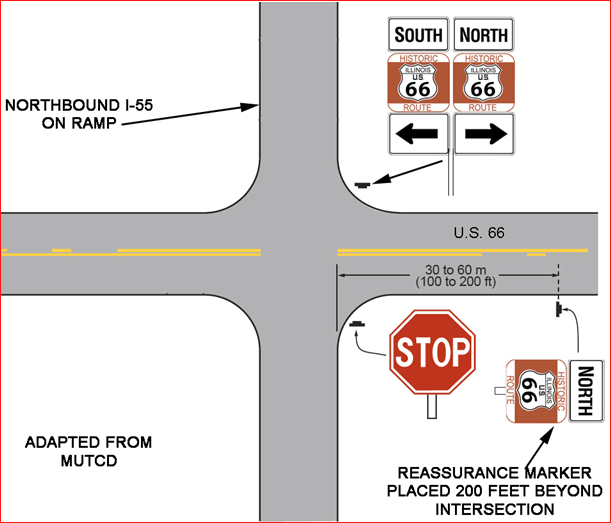
And last but not least are signs used to mark a route that makes an abrupt turn leaving a facility whose continuation turns into a facility bearing no route designation. Such abrupt turns need to be well signed so that motorists don't miss their turn and end up getting that sinking "dead end feeling" a few short miles down the road. Such abrupt turns are frequently encountered in urban or suburban areas but occasionally in rural areas as well and need to be signed as shown:

It is sincerely hoped that these illustrations will help clarify and crystallize in the minds of many what is sorely needed for Route 66 that is largely missing at the current time (2012). This is actually not "rocket science". Indeed, these are the kinds of route marker arrangements that Americans are accustomed to seeing along the Nation's signed routes. What is it going to take to get them installed along our most famous highway?
Another issue that needs to be addressed is the loss of signs from thieves, vandals or traffic accidents where the precious few markers that have been installed get destroyed or stolen. Travelers in the know who suspect that a sign or signs is/are missing should report it their respective State Route 66 Association and DOT.
 It has been the focus of this website to get signage installed - and maintained - on Route 66 through the restoration of the official "66" U.S. Route designation along a combination of historic and modern alignments. We believe that this would be the most thorough, efficient and economically viable way to re-sign the Route. It can also be said that the Nation's recreation and vacation-oriented travelers who go looking for Route 66 fully expect to see U.S. Route markers, not state route markers or county markers - U.S. Route markers. For that reason it is probably no coincidence that the "Historic" and "Byway" markers have been made to look as much as possible like U.S. Route markers. But additional, official U.S. Route markers would make a big improvement in visibility and user friendliness of Route 66.
It has been the focus of this website to get signage installed - and maintained - on Route 66 through the restoration of the official "66" U.S. Route designation along a combination of historic and modern alignments. We believe that this would be the most thorough, efficient and economically viable way to re-sign the Route. It can also be said that the Nation's recreation and vacation-oriented travelers who go looking for Route 66 fully expect to see U.S. Route markers, not state route markers or county markers - U.S. Route markers. For that reason it is probably no coincidence that the "Historic" and "Byway" markers have been made to look as much as possible like U.S. Route markers. But additional, official U.S. Route markers would make a big improvement in visibility and user friendliness of Route 66.
The intent of the Route 66 Recommissioning Initiative is to add signs and not replace any existing "Historic" or "Byway" signs. Therefore, we continue to advocate a new, official U.S. Route designation. At the same time, however, we recognize that there are other well-intentioned and laudable groups who are fighting to get signage improved without a new U.S. Route designation.
One remarkable and highly commendable effort we are aware of is the sign the route initiative of the Route 66 chamber of commerce. We support the Chamber and all interested Route 66 enthusiasts should be encouraged to embrace and help support their efforts.
A rather exciting and encouraging development is that Rand McNally began showing Route 66 on their well known Road Atlas of the United States for the first time in nearly two and a half decades beginning with the 2010 printed edition. Sadly, The Route is still not indicated on their urban inset maps as of 2012. Another development was that Google Maps were also showing the Route on their online atlases as of 2012 in every state except California which can be seen here: http://maps.google.com/maps?hl=en&tab=wl. Do a search from that site for any Route 66 town and you should find it!
It is hoped that having Route 66 on a map - any map - might also increase pressure to get it better signed in the field especially if more people become frustrated after finding it on a map but unable to find it out on the highway.
Summary and Conclusion
Rutgers University has found that poor, inadequate and inconsistent signage is the number one complaint of Route 66 travelers. It can be deduced from their findings that if Route 66 is to truly succeed at luring large numbers of travelers off of the parallel Eisenhower Interstate highways, then good signage is absolutely necessary.
A large increase in traffic resulting from good signage might just be what it will take to save many struggling, historic businesses along The Route. People who attempt to profit from Route 66 nostalgia through the sale and distribution of Route 66 related paraphernalia would only stand to gain from a better signed and more visible Route 66. So, our conclusion is that a well signed Route 66 would benefit everyone. It would benefit roadside businesses, it would benefit the communities the Route serves, it would benefit Route 66 nostalgia enterprises and most of all it would benefit travelers. So, let's all get together and re-sign Route 66!
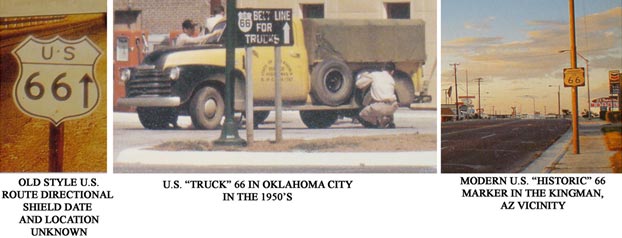
Return to Home
|
